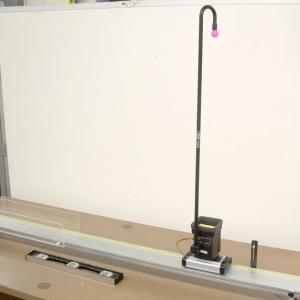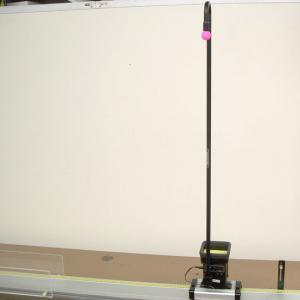College of Liberal Arts & Sciences
1D60.70 - Parabolic Trajectory - Bomb Run
Attach the drop rod to the ballistic cart and turn it so that the ball will fall into the cart when triggered. Note that you must use the special pink balls for this as they are made to be magnetically suspended from the rod until triggered. When triggered the ball will appear to drop straight down into the cart when observed by a small wireless camera placed into the cart catch bin. However, the view by the audience is that the ball falls in a parabolic path before landing into the moving cart.
Turn the rod so that the ball will fall outside the cart when triggered. Also place the track so that it is at the very edge of the table and will allow the ball to fall all the way to the floor. Do some math and determine where a cup needs to be place on the floor so that it can catch the ball when the "bomb run" takes place. One of the spring launchers designed for the track can also be used to insure that cart velocity is the same for each run.
- Scott Hertting, "Stunt Barbie - A Laboratory Practicum Combining Velocity and Constant Acceleration", TPT, Vol. 49, #4, April 2011, p. 238.
- Greg W. Lowe and Eric Ayars, "Measuring the Flight Speed of Fire Bombers from Photos: An In-Class Exercise in Introductory Kinematics", TPT, Vol. 48, #2, Feb. 2010, p. 106.
- Jeffrey Wetherhold, "A Toy Airplane for Projectile - Motion Experiments", TPT, Vol. 39, #2, Feb. 2001, p. 116.
- Doug Forrest, "Raw Eggs - Moving Target", TPT, Vol. 37, # 6, Sept. 1999, p. 371.
- Andrew DePino, Jr., "Easy Projectile- Motion Demonstrations", TPT, Vol. 37, #5, May 1999, p. 266.
- 7-2.12, Harry F. Meiners, Physics Demonstration Experiments.
Disclaimer: These demonstrations are provided only for illustrative use by persons affiliated with The University of Iowa and only under the direction of a trained instructor or physicist. The University of Iowa is not responsible for demonstrations performed by those using their own equipment or who choose to use this reference material for their own purpose. The demonstrations included here are within the public domain and can be found in materials contained in libraries, bookstores, and through electronic sources. Performing all or any portion of any of these demonstrations, with or without revisions not depicted here entails inherent risks. These risks include, without limitation, bodily injury (and possibly death), including risks to health that may be temporary or permanent and that may exacerbate a pre-existing medical condition; and property loss or damage. Anyone performing any part of these demonstrations, even with revisions, knowingly and voluntarily assumes all risks associated with them.

